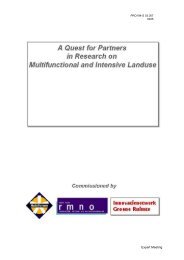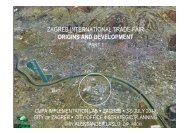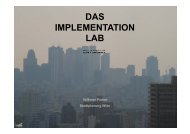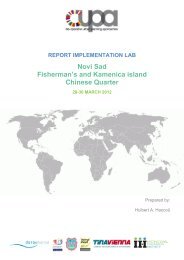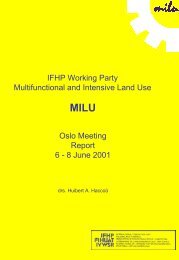Stockholm Kista Workshop Report - Habiforum
Stockholm Kista Workshop Report - Habiforum
Stockholm Kista Workshop Report - Habiforum
You also want an ePaper? Increase the reach of your titles
YUMPU automatically turns print PDFs into web optimized ePapers that Google loves.
In the so called Riem Committee of the City Council, nearly all political decisions concerning Messestadt<br />
Riem are pooled. Munich’s mayor is head of it. It makes decisions across departmental competencies<br />
possible within short time. A similar platform – the ‘Riem Coordination Group’ – was created within the<br />
administration to support integrated management and development. Different departments of the city and<br />
the developing company MRG (see below) participate in this Coordination Group.<br />
A contract between a newly created development company – the Massnahmenträger Riem Gesellschaft<br />
(MRG) – and the city defined the tasks of this developer. MRG was created by the financing consortium of<br />
banks. Its development measures comprise measures on behalf of the city as well as measures on its own<br />
responsibility. A board that is identical in persons with the Riem Committee of the City Council establishes<br />
the link between city and developer. Its task is to control and to take decisions in areas where MRG is<br />
active on behalf of the city. MRG has to develop the technical, social, and cultural infrastructure of the Riem<br />
district. Building the underground line and the new fair trade are excluded from these tasks.<br />
The Department of Urban Planning is responsible for the overall project coordination, and the preparation of<br />
the binding development scheme. There was a special sub-unit for Messestadt Riem in the beginning. The<br />
Department of Labour and Economic Development is responsible for the structure of the business sites,<br />
and selects the companies that settle there. As well, it supported the relocation of the Trade Fair Centre<br />
from near the city centre to Riem, and promotes its further development. The Communal Services<br />
Department is contractor in the selling process of real estates.<br />
Since 1999, the Department of Social Affairs provides for a participation project for inhabitants – the<br />
MessestadtRiem Dialog – together with a small private company. It is financed by the city for a limited time;<br />
its financial means are quite limited. Its task is to be a neutral mediator between inhabitants of Messestadt<br />
Riem and the administration. The departments for social affairs, planning, culture, and building construction<br />
as well as the MRG are part of a steering committee for the participation project. Besides MessestadtRiem<br />
Dialog, the City District Committee represents the specific interest of the district.<br />
Nearly all other departments of the City of Munich are also involved in the development of “Messestadt<br />
Riem”, since building measures as well as social and cultural aspects have been integrated in the overall<br />
strategy from very early on.<br />
At this stage of investigation, the following factors could be seen as positive factors or as main obstacles for<br />
implementation:<br />
Positive factors for implementation:<br />
• The whole Riem project is a prime example of successful co-operation between the city and the Land of<br />
Bavaria.<br />
• The relocation of the trade fair was an especially important issue for the State of Bavaria, which<br />
provides part of the funding.<br />
• The co-operation of the different levels of government and the mix of uses, especially the location of the<br />
trade fair, made it possible to provide the new district with a high standard of public (transport)<br />
infrastructure.<br />
• The creation of the City Council Riem Committee and the Riem Coordination Group provide for quick<br />
decision making and better cooperation of city departments.<br />
• The management and funding structures of “Messestadt Riem” are innovations. It is open to<br />
investigation, how they influence the implementation in regard to the different aims of the project.<br />
Main obstacles for implementation:<br />
• Municipal real estates have to be sold at (high) market prices by law. It is open to question, whether<br />
there was a negative influence on the realisation of the aspired ‘urban, green, and compact’ district and<br />
especially its innovative aspects.<br />
• Commercial infrastructure (like the shopping centre in Riem Arcaden) is still not ready, although the first<br />
inhabitants moved to Riem in 1998/99. This is due to economic reasons on the side of private investors<br />
(not enough demand). Is the lack of shopping facilities an obstacle for the development of the new<br />
MILUnet <strong>Stockholm</strong> <strong>Kista</strong> <strong>Workshop</strong> <strong>Report</strong> 57



